Complete Guide to Palo Alto Battlefield National Historical Park in Texas, including things to do, history, nearby lodging and camping, directions, and so much more.
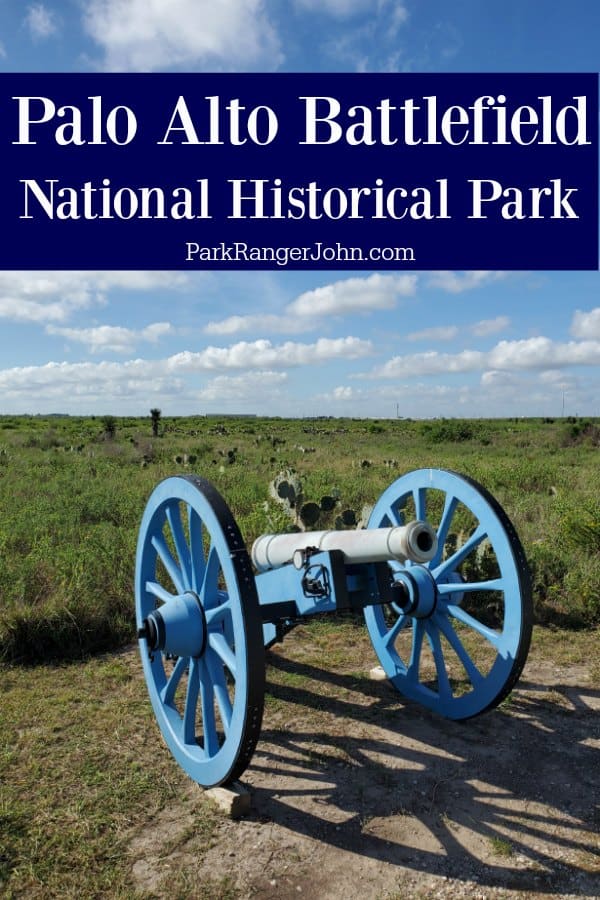
Palo Alto Battlefield National Historical Park
Palo Alto Battlefield National Historical Park is the only National Park Service site to interpret the US - Mexican War. The park is located in Brownsville, Texas near the southern border with Mexico.
About Palo Alto Battlefield National Historical Park
Palo Alto National Historical Park preserves important battlefields from the US-Mexican War. The park interprets the battle between the United States and Mexican troops on the prairies of Palo Alto.
The May 8, 1846 battle at Palo Alto was the first and second battle in what would become a two year long war between the United States and Mexico.
Across the field more than 3,200 Mexican soldiers were lined up blocking their path.
Within minutes the field erupted in artillery fire. For five hours the two armies engaged in a fierce battle. This battle was the first battle of what became a two-year long war.
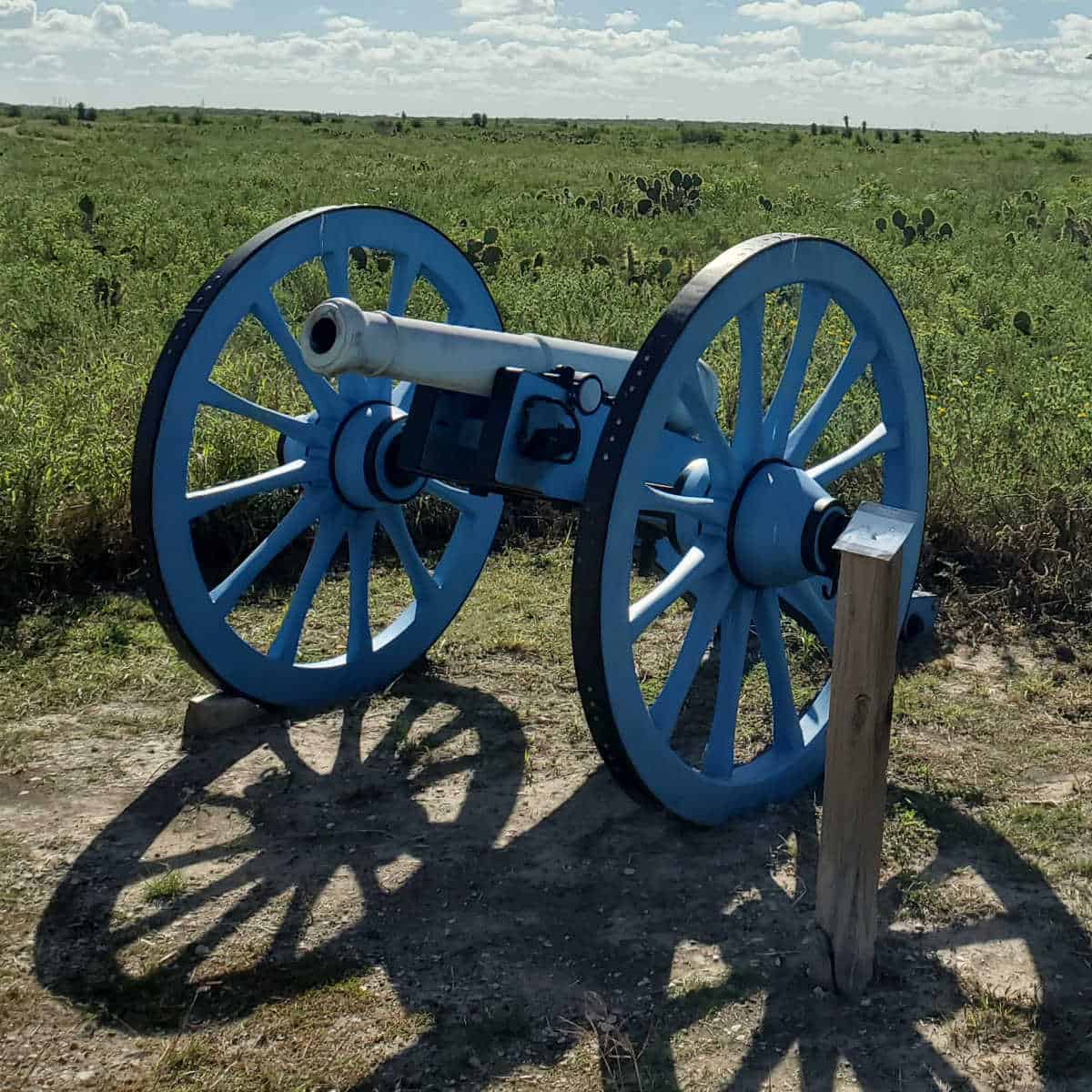
Is Palo Alto Battlefield National Historical Park worth visiting?
Palo Alto Battlefield National Historical Park is a fascinating destination for those interested in American history and military conflicts. Whether you are interested in history, nature, or both, this park is a great place to explore and learn.
We really enjoyed our visit to the park. It was interesting learning about a part of American History that you do not hear about often.
History of Palo Alto Battlefield National Historical Park
The Palo Alto National Historical Park protects and preserves the battlefield where the Mexican-American War began on May 8th, 1846. The Palo Alto National Historical Park also includes the site of the Battle of Resaca de la Palma, which took place the day after Palo Alto on May 9th.
Tensions between the U.S and Mexican governments reached a breaking point when the U.S. annexed the state of Texas. The Texas state boundary and the U.S-Mexican border became a hotly disputed topic.
Fearful that the Mexicans would retaliate against the annexation of Texas, American President James Polk sent forces to the disputed border region. Viewed as an act of war by the Mexican President, fighting erupted along the Rio Grande River.
The Start of the Mexican-American War (1846 - 1848)
Issues between Mexico and the United States of America began when American President James Polk wanted to expand U.S territory. Polk believed that America needed to stretch across the continent. This expansion would mean incorporating most of Mexico into the United States.
The State of Texas gained independence from Mexico after a failed war in 1836. Texans gained their independence but initially were not accepted into the United States. The U.S was against bringing any more slave-owning states into the Union. This changed in 1845
The U.S brought Texas into the Union in 1845, officially annexing the state. Polk tried to buy more territory from the Mexican government and offered to purchase California and New Mexico. Much to Polk's dismay, the Mexican government refused.
Before the Battle
Polk was angered over Mexican President José Joaquín de Herrera’s refusal and sent U.S forces to the contested border region. Under the leadership of General Zachary Taylor, U.S forces arrived along the Rio Grande in April 1846.
The American’s believed the border with Mexico was at the Rio Grande River, while the Mexican government believed it lay at the Nueces River. The Mexican government considered American soldiers arriving in the region as an act of aggression and an invasion of Mexican territory.
The Mexican government retaliated by sending its forces to meet the Americans on April 25th. The Mexican army crossed the Rio Grande and attacked Taylor's position killing around 16 men. The Mexican army then began a siege of Fort Texas.
The Battle of Palo Alto
On May 8th, 1846, the Battle of Palo Alto began when Taylor marched his force of 2,000 to meet the Mexican army of over 3,000 strong led by General Mariano Arista. The two armies clashed on the prairie of Palo Alto.
Gen. Arista positioned his troops in a mile-long line spanning the field. The Americans entered from the northern edge but did not charge the Mexican position. Instead, the two sides swopped artillery fire. The American artillery fire tore the Mexican defensive line to shreds.
Gen. Arista made two failed charges on the right and left U.S flank, but brush and uneven land slowed the first charge. The Americans were able to prepare and easily repelled the charge. The second charge was cut short due to the effectiveness of the U.S artillery fire.
Retretat to Resaca de la Palma
The Mexican artillery fire had little impact on the U.S defensive line with some cannonballs reportedly bouncing across the battlefield. The Americans merely had to step out of the way to avoid the cannons.
The Mexican casualties vastly outnumbered the U.S, with Arista losing over 100 men. Arista pulled back his men from Palo Alto as night fell, unwilling to enter into the second day of battle with Taylor's forces. He moved his army to Resaca de la Palma.
Taylor attacked the Mexican army's position on May 9th after following its retreat. The American's quick capture of the Mexican guns caused a huge panic among the Mexican forces. The Mexican troops fled across the Rio Grande.
A Declaration of War
U.S President Polk formally declared war with Mexico on May 13th, 1846. Polks reasoning behind the declaration was that American blood had been spilled on American soil due to Mexican aggression.
The Mexican-American War was the first U.S conflict fought mainly on foreign soil. The Palo Alto National Historical Park is the only national park that preserves a battlefield from the Mexican-American War.
During this conflict, Zachary Taylor rose to fame and was later elected as the 12th President of the United States. The war, which began at the site protected by the Palo Alto National Historical Park, resulted in Mexico losing around one-third of its territory.
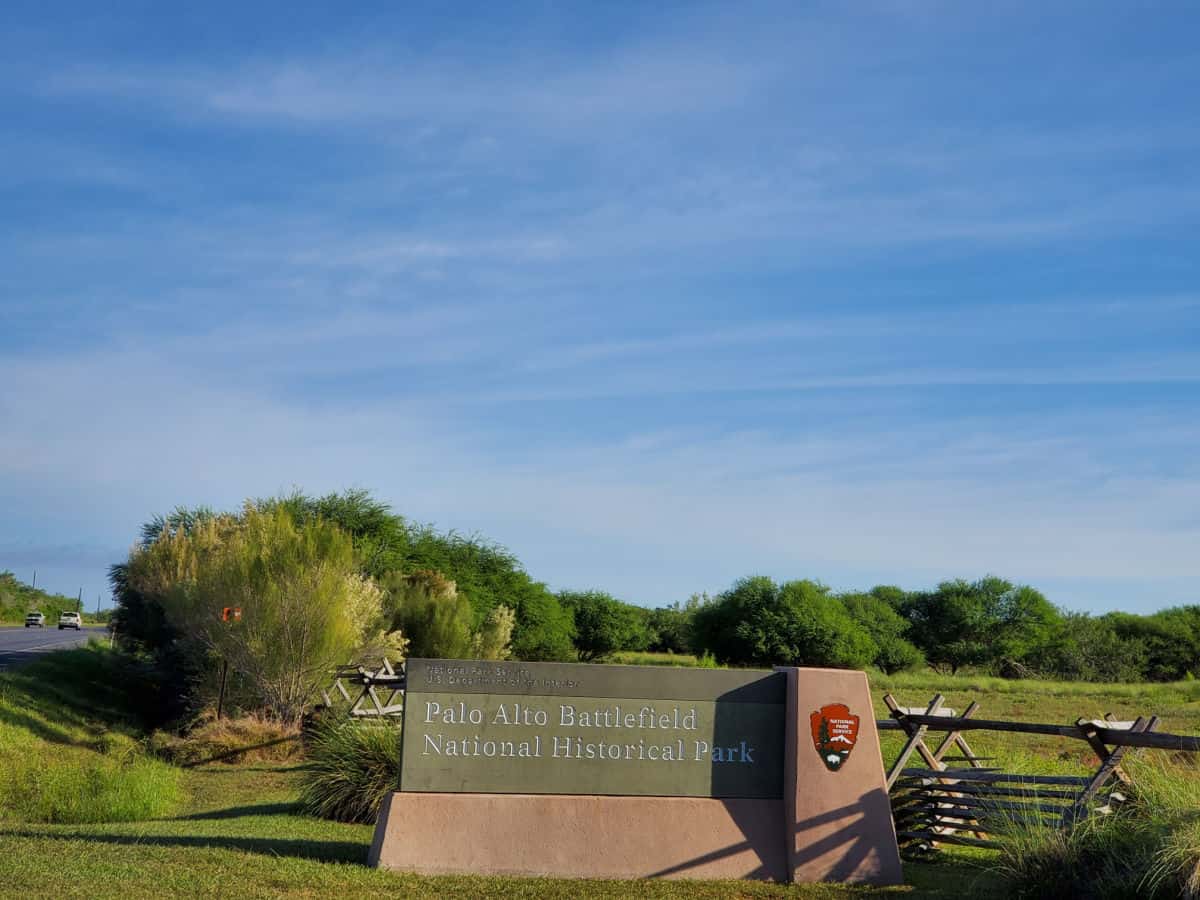
Things to know before your visit
Entrance fee
$0.00 - There is no entrance fee to enter the park or the visitor center.
Learn more about National Park Passes for parks that have an entrance fee.
$80.00 - For the America the Beautiful/National Park Pass. The pass covers entrance fees to all US National Park Sites and over 2,000 Federal Recreation Fee Sites for an entire year and covers everyone in the car for per-vehicle sites and up to 4 adults for per-person sites.

Buy your pass at this link, and REI will donate 10% of pass proceeds to the National Forest Foundation, National Park Foundation, and the U.S. Endowment for Forestry & Communities.
National Park Free Entrance Days -Mark your calendars with the five free entrance days the National Park Service offers annually.
Time Zone
The time zone in Brownsville, Texas is Central Standard Time (CST). During daylight saving time (DST), which is typically observed from the second Sunday in March to the first Sunday in November, the time zone in Brownsville, Texas is Central Daylight Time (CDT).
Pets
Leashed dogs are allowed in parking lots and on park trails. Only service dogs are allowed inside the visitor center and must be accompanied by a handler.
Cell Service
Cell service can be limited or unreliable, particularly in some areas of the park that are more remote.
Park Hours
The park is open daily from 8 AM to 5 PM but the Visitor Center is closed on Mondays. Park trails close at 4:30 PM and all gates are locked at 5 PM.
The visitor center closes Thanksgiving Day, Christmas, and New Year's Day.
Wi-Fi
Public Wi-Fi is available at the park.
Insect Repellent
Insect repellent is always a great idea when outdoors, especially if you are around any body of water.
We use Permethrin Spray on our clothes before our park trips.
Water Bottle
Make sure to bring your own water bottle and plenty of water with you. Plastic water bottles are not sold in the park.
Parking
There is a nice size parking area near the visitor center.
Food/Restaurants
There are no restaurants within the park. There are nearby restaurants in downtown Brownsville, Texas
Gas
There are no gas stations within the park.
Drones
Drones are not permitted within National Park Sites.
National Park Passport Stamps
National Park Passport stamps can be found in the visitor center.
We like to use these circle stickers for park stamps so we don't have to bring our passport book with us on every trip.
The National Park Passport Book program is a great way to document all of the parks you have visitied.
You can get Passport Stickers and Annual Stamp Sets to help enhance your Passport Book.
Electric Vehicle Charging
There are currently 5 electric vehicle (EV) charging stations within a 10-mile radius of the center of Brownsville, TX.
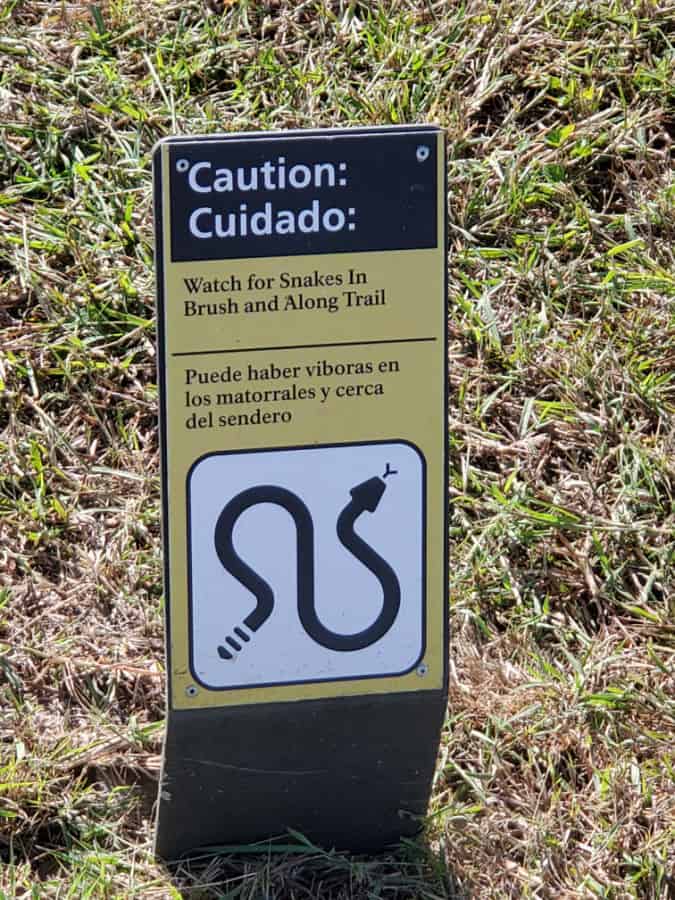
Details about Palo Alto Battlefield National Historical Park
Size - 3,400 acres
Check out how the park compares to other National Parks by Size.
Date Established
December 19, 1960 - Designated a National Historic Landmark
November 10, 1978 - Designated as Palo Alto Battlefield National Historic Site
March 30, 2009 - Re-designated as Palo Alto Battlefield National Historical Park
Visitation
In 2022, Palo Alto Battlefield NHP had 196,252 park visitors.
In 2021, Palo Alto Battlefield NHP had 128,852 park visitors.
In 2020, Palo Alto Battlefield NHP had 97,860 park visitors.
In 2019, Palo Alto Battlefield NHP had 149,733 park visitors.
Learn more about the most visited and least visited National Parks in the US
National Park Address
7200 Paredes Line Road, Brownsville, TX 78526
National Park Map
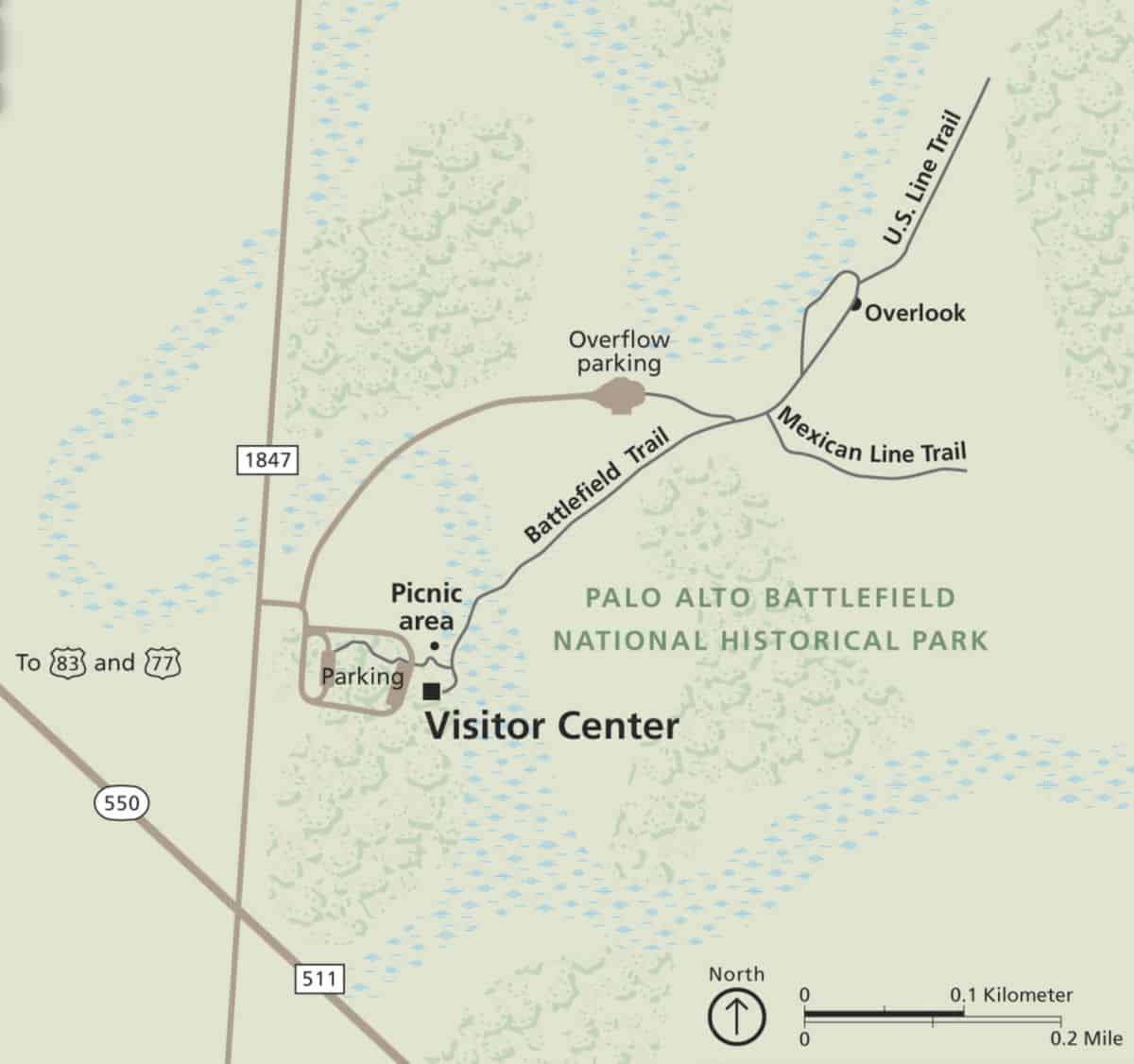
Where is Palo Alto Battlefield National Historical Park?
The park is located on Brownsville's north side, near the city of Los Fresnos. It is just north of the intersection of FM 1847 (Paredes Line Rd.) and FM 511/FM 550.
Estimated distance from major cities nearby
- Dallas, TX - 521 miles
- Corpus Christi, TX - 155 miles
- Laredo, TX - 203 miles
- San Antonio, TX - 271 miles
- Houston, TX - 349 miles
- Austin, TX - 345 miles
Estimated Distance from nearby National Park
Big Bend National Park - 588 miles
Hot Springs National Park - 758 miles
Guadalupe Mountains National Park - 732 miles
White Sands National Park - 918 miles
Saguaro National Park - 1,133 miles
Where is the National Park Visitor Center?
The visitor center is located at the northern end of the park, near the entrance, and is a large, single-story building with a distinctive architectural design.
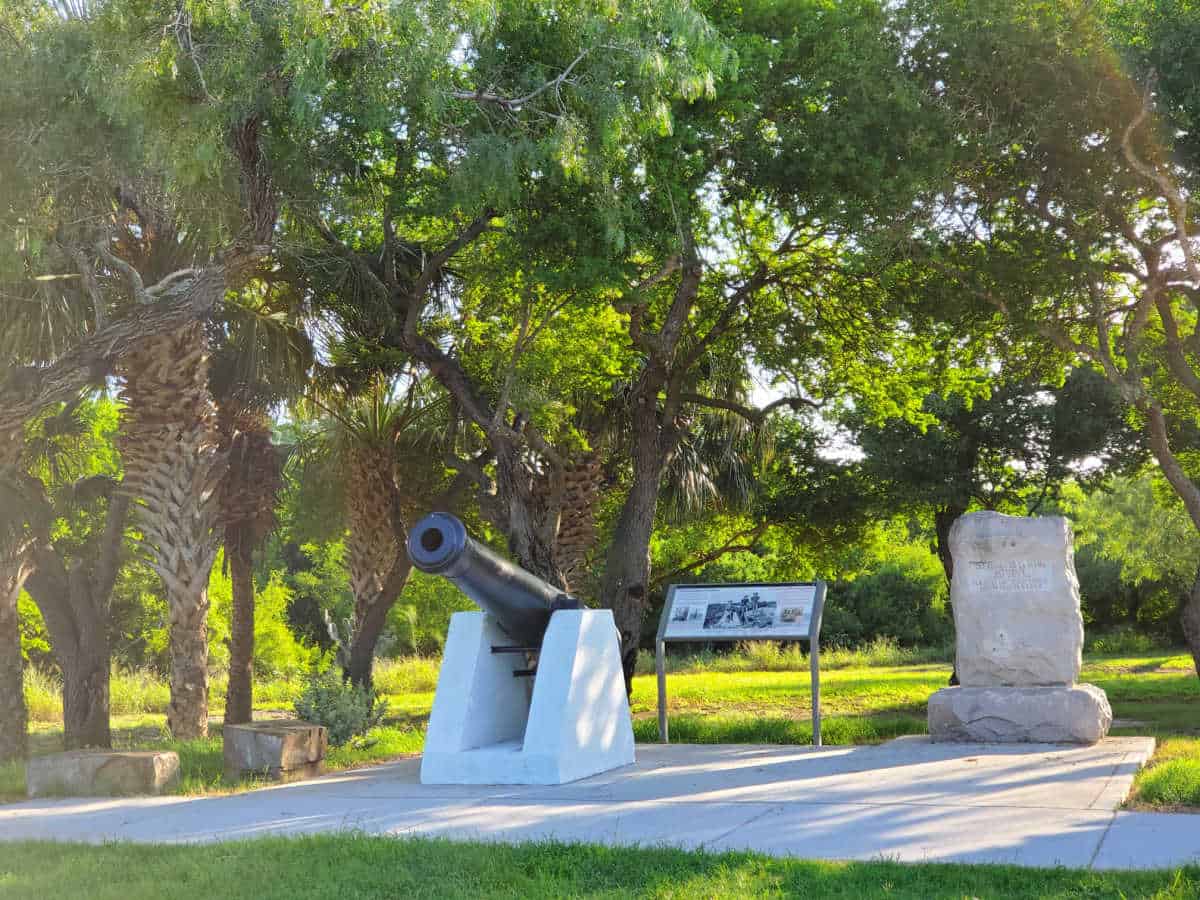
Getting to Palo Alto Battlefield National Historical Park
Closest Airports
- Brownsville/South Padre Island International Airport (BRO / KBRO)
International Airports
- Valley International Airport (HRL / KHRL)
- McAllen-Miller International Airport (MFE / KMFE)
By Bike
The park features a trailhead for the Brownsville Historic Battlefield Hike and Bike Trail. Be sure to ask for a trail guide at the front desk.
Driving Directions
The park is approximately five miles north of downtown Brownsville, TX.
From outside Brownsville:
From Rt. 77/83, take the FM 511 (Palo Alto Battlefield) exit. Turn left onto FM 511. Drive east approximately two miles to FM 1847 (Paredes Line Rd.) Keep right to avoid the toll road overpass. Turn left onto FM 1847 (Paredes Line Rd.) Park entrance will be on the right, about 600 feet from the corner.
From Brownsville:
Travel north on FM 1847 (Paredes Line Rd.) towards Los Fresnos, TX. Keep right as you approach the FM 1847 (Paredes Line Rd.) and FM 511/FM 550 intersection. Park entrance will be on the right, about 600 feet from the corner.
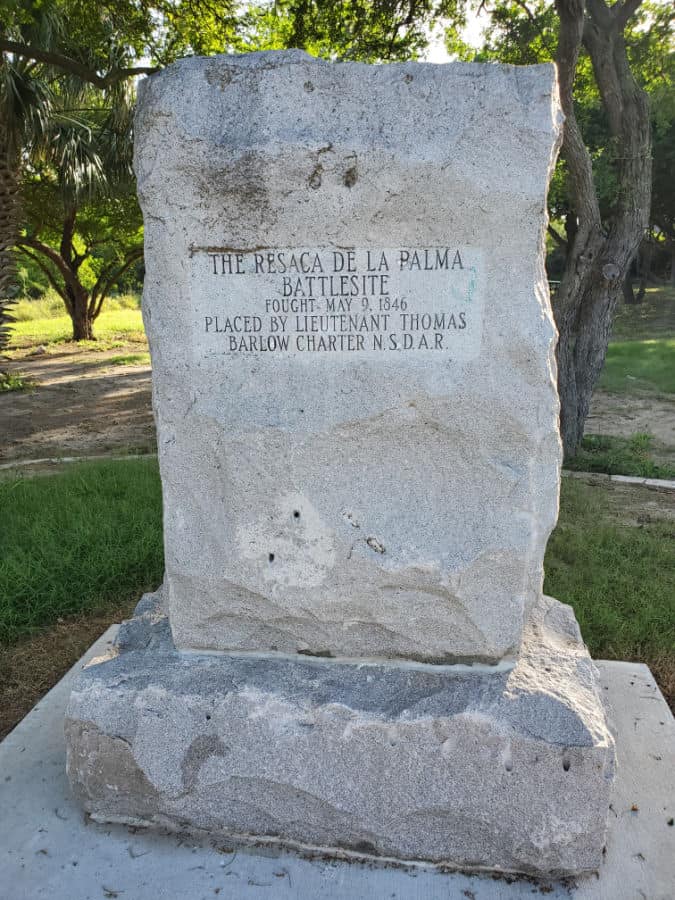
Best time to visit Palo Alto Battlefield National Historical Park
The best time to visit Palo Alto Battlefield National Historical Park is during the cooler months of the year, from November to March.
During this time, temperatures are mild and pleasant, making it comfortable to explore the outdoor areas of the park. Additionally, this period coincides with the peak birdwatching season, as many migratory birds pass through the area on their way south for the winter.
Weather and Seasons
The hottest season starts from May 22nd to September 22nd, when the average daily high temperature is above 90 degrees.
The coldest season starts from December 4th to February 19th, when the average daily high temperature is below 75 degrees.
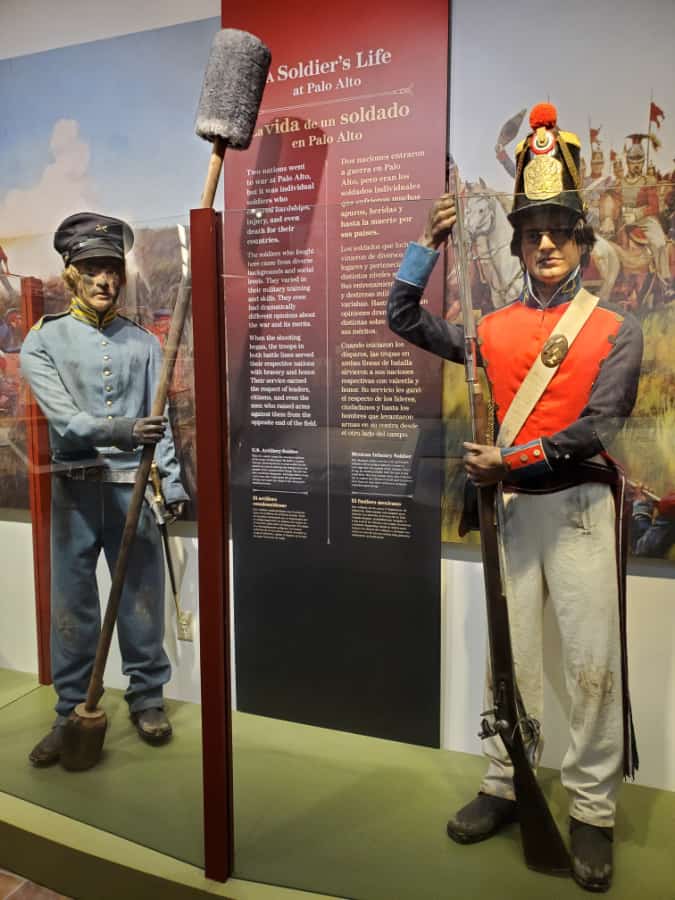
Best Things to do in Palo Alto Battlefield National Historical Park
We suggest planning a couple of hours for visiting Palo Alto Battlefield NHP. This is the only National Park Service unit that talks about the US - Mexican War.
Visitor Center
Start your visit with a trip to the visitor center to pick up the park brochures, maps, and find out what is happening within the park. There is a small bookstore with national park books and items related to the battlefield.
The park’s visitor center is completely wheelchair accessible.
Palo Alto Battlefield Visitor Center is the only bathroom and water fountains within the park.
Park Movie - War on the Rio Grande
The park movie does a great job detailing what happened during the Mexican US War. It describes the importance of the Palo Alto Battlefield.
Junior Ranger Program
The junior ranger program can be completed within the visitor center and on the park trails. Plan to spend 30 minutes to an hour depending on the age of the participant.
Resaca De La Palma Battlefield
The Resaca de la Palma Battlefield is about 6 miles from the visitor center. The battlefield has a walking trail around the park, multiple interpretive panels, a bathroom and cannon.
Guided Tours
Guided tours are available from December 1st to April 1st depending on staffing and weather.
For the latest information about tours, contact the front desk at (956) 541-2785 x333
Bird Watching
Captain John Porter McCown was a birder back in 1846. He is credited with discovering eight new bird species including the Black-bellied Whistling Duck, Green Kingfisher, Vermilion Flycatcher, Verdin, Cactus Wren, Pyrrhuloxia, Great-tailed Grackle and the Olive Sparrow.
Part of the Mexican troops Captain Jean Louis Berlandier was a noted naturalist. He also documented many birds of the Rio Grande Valley.
The park visitor center has a fantastic bird checklist for the park. Some of the birds you may see include:
- Great Blue Heron
- Great Egret
- Reddish Egret
- Turkey Vulture
- Harris's Hawk
- White Tailed Hawk
- Plain Chachalaca
- Northern Bobwhite
- Killdeer
- Common Ground Dove
- Common Pauraque
- Ladder-backed Woodpecker
- Horned Lark
- Curve Billed Thrasher
- Northern Cardinal
- Olive Sparrow
- Cassin's Sparrow
- Brown-headed Cowbird
You may also see horned lizards, snakes and other native species to the southern tip of Texas.
Palo Alto Battlefield has three habitat types including grassland called salt prairie, scrubland, and freshwater wetlands.
Native Plant Species include Prickly pear, Yucca, Camphor Daisy, honey mesquite, spiny hackberry, Texas ebony, lotebush, Snake-eyes, Cat-claw acacia, colima, and so many more.
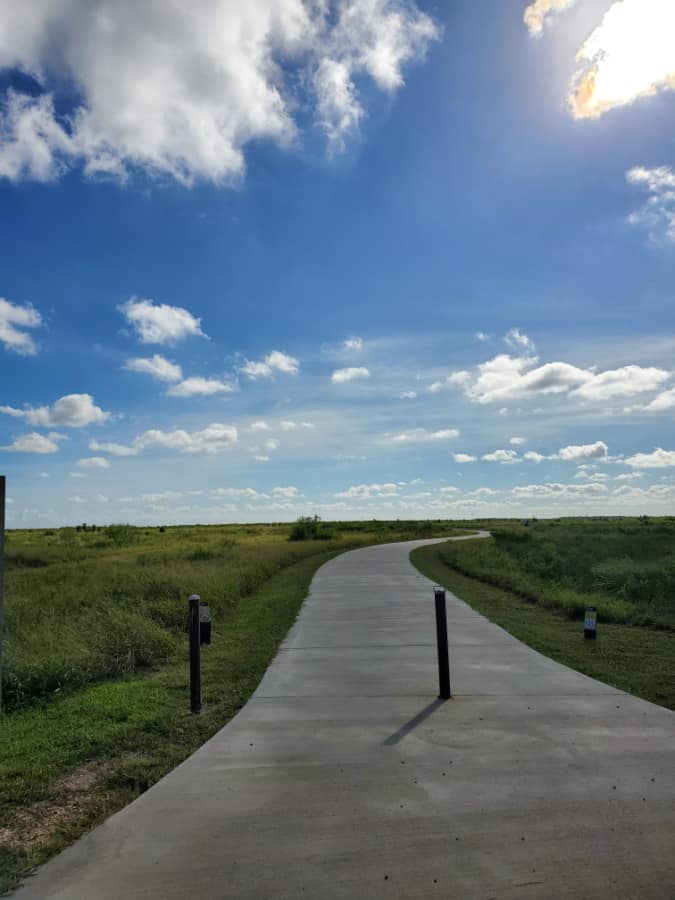
Hiking in Palo Alto Battlefield National Historical Park
Always carry the 10 essentials for outdoor survival when exploring.
Make sure to pack sunscreen, a hat, sunglasses and sun protection. There is no shade while on the trail.
Battlefield Trail
The Battlefield Trail is an interpretive trail around the battlefield. Be prepared for the Texas sun and also snakes.
As you walk around the battlefield you will see a landscape very similar to what soldiers encountered in 1846.
The vegetation is typical of a south Texas coastal prairie. You will see a thick grass with razor sharp points called Gulf Cordgrass.
The Battlefield Overlook provides a view of a point between the opposing battle lines at the western edge of the battlefield.
This is not an area that you want to leave the trail!
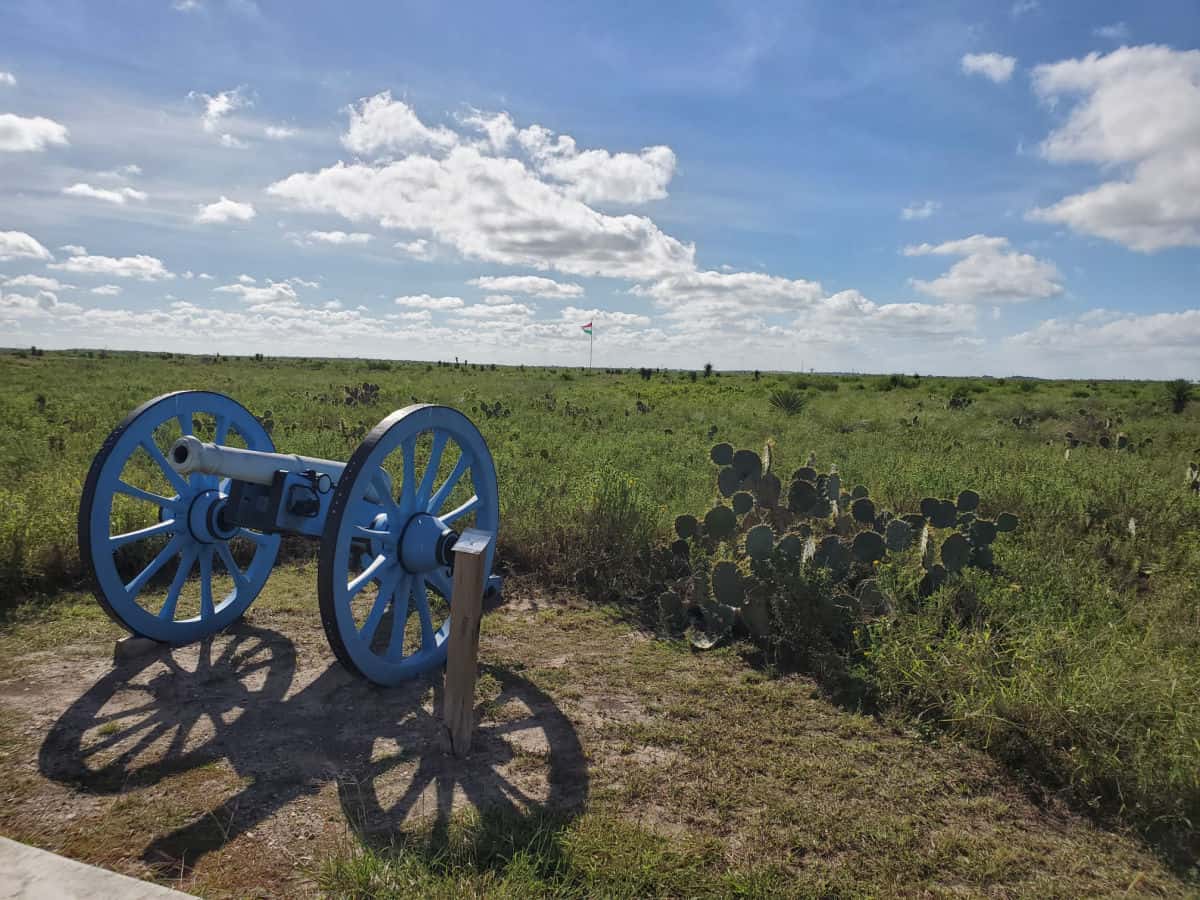
How to beat the crowds
We did not experience any crowds during our visit. I am pretty sure we only saw 2 other visitors in the entire time we were in the park.
Where to stay when visiting
There are no National Park Lodges within the park.
Nearby Lodging includes:
La Quinta Inn & Suites by Wyndham Brownsville North - Free continental breakfast, laundry facilities, and a gym are just a few of the amenities provided at La Quinta Inn & Suites by Wyndham Brownsville North. Stay connected with free in-room Wi-Fi, and guests can find other amenities such as a business center.
Fairfield Inn & Suites by Marriott Brownsville North - Located close to Valley Baptist Medical Center and Gladys Porter Zoo, Fairfield Inn & Suites by Marriott Brownsville North provides a free breakfast buffet, a free roundtrip airport shuttle, and a poolside bar. Free in-room Wi-Fi is available to all guests, along with a grocery/convenience store and dry cleaning/laundry services.
Rooms at The Pecan - Located close to Brownsville Sports Park and Sunrise Mall, Rooms at The Pecan provides a garden.
Deluxe 6 Inn & Suites - Consider a stay at Deluxe 6 Inn & Suites and take advantage of free continental breakfast, laundry facilities, and a business center. Stay connected with free in-room Wi-Fi.
Click on the map below to see current vacation rentals and lodges near the park.
Camping
There are no National Park Campgrounds within the park.

For a fun adventure check out Escape Campervans. These campervans have built in beds, kitchen area with refrigerators, and more. You can have them fully set up with kitchen supplies, bedding, and other fun extras. They are painted with epic designs you can't miss!
Escape Campervans has offices in Vancouver, Seattle, Portland, San Francisco, Las Vegas, Los Angeles, Phoenix, Salt Lake City, Denver, New York, and Orlando
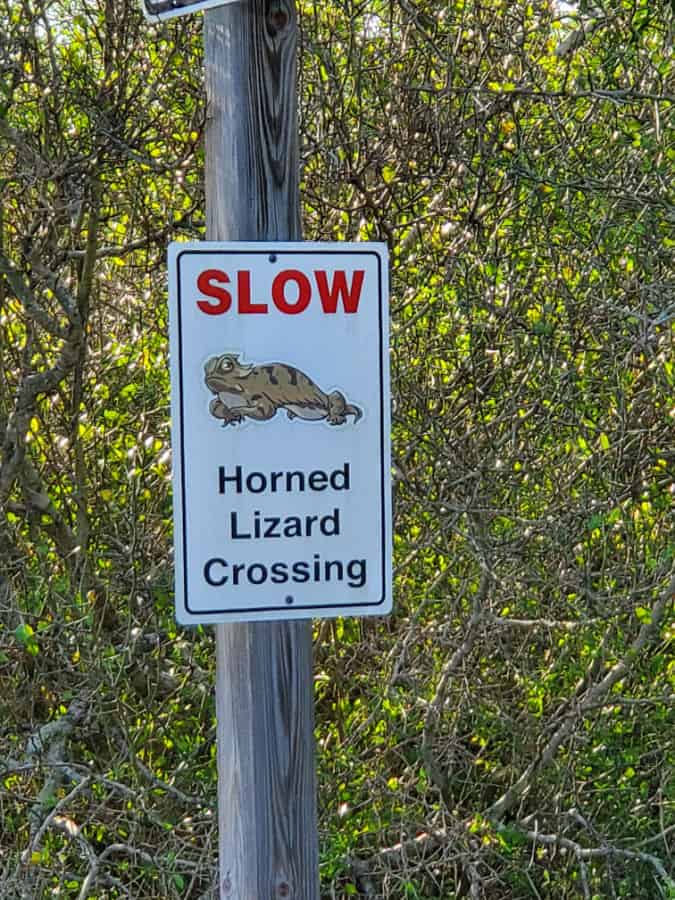
Parks Near Palo Alto Battlefield National Historical Park
Padre Island National Seashore
San Antonio Missions National Historical Park
Lyndon B Johnson National Historical Park
Waco Mammoth National Monument
Check out all of the National Parks in Texas along with neighboring National Parks in Arkansas, National Parks in Louisiana, New Mexico National Parks, and Oklahoma National Parks
Make sure to follow Park Ranger John on Facebook, Instagram, Pinterest, and TikTok





Leave a Reply